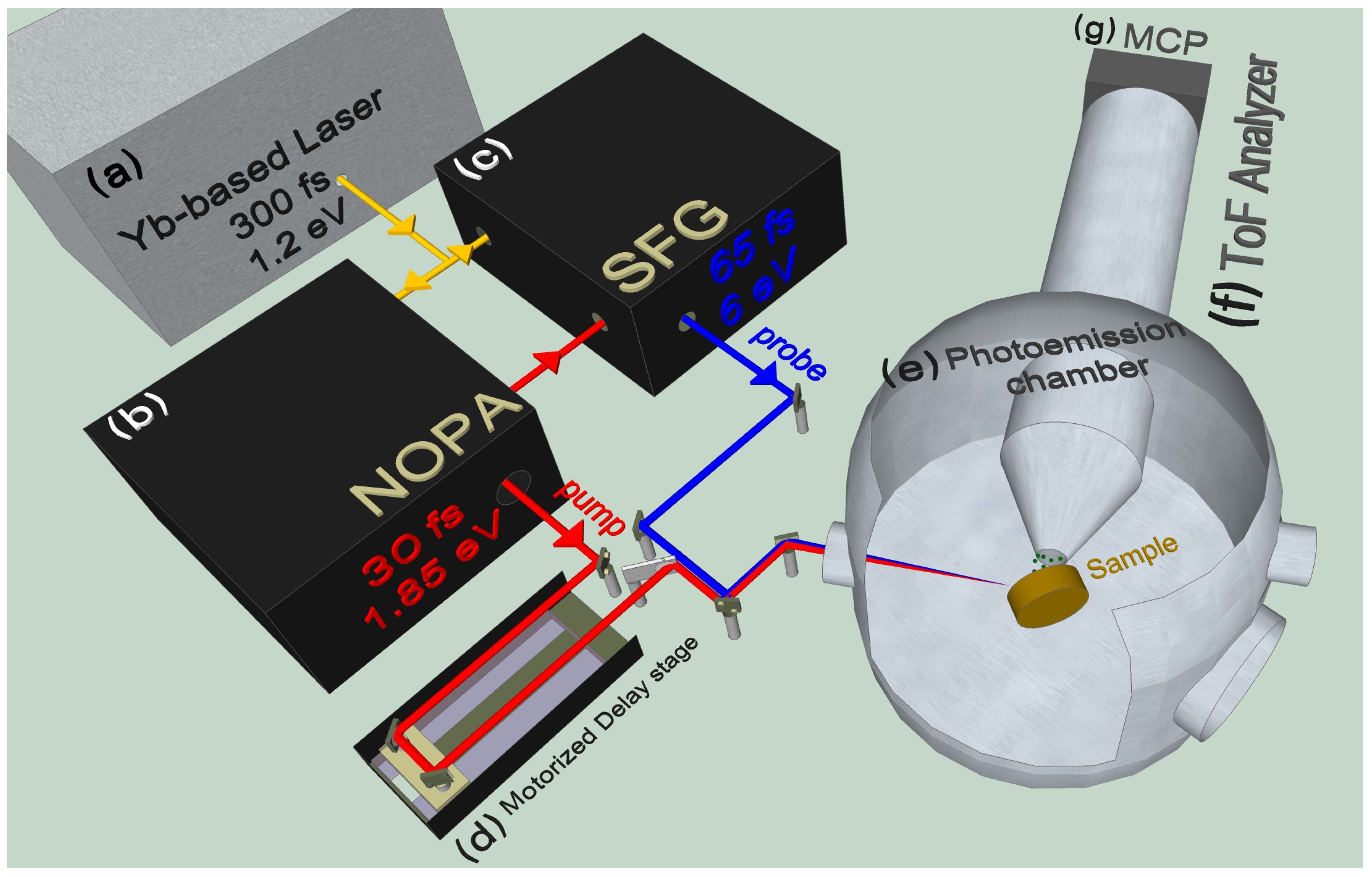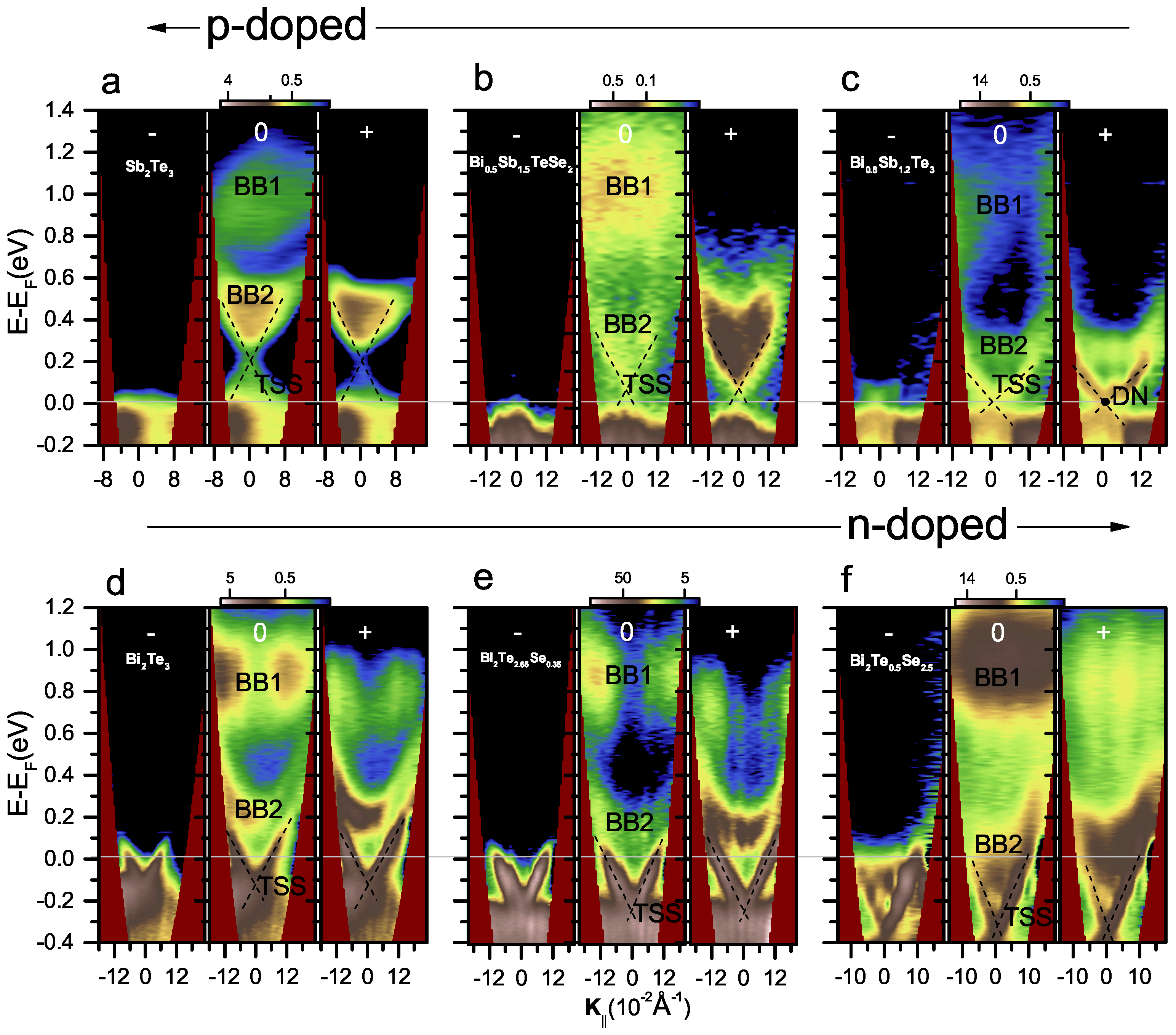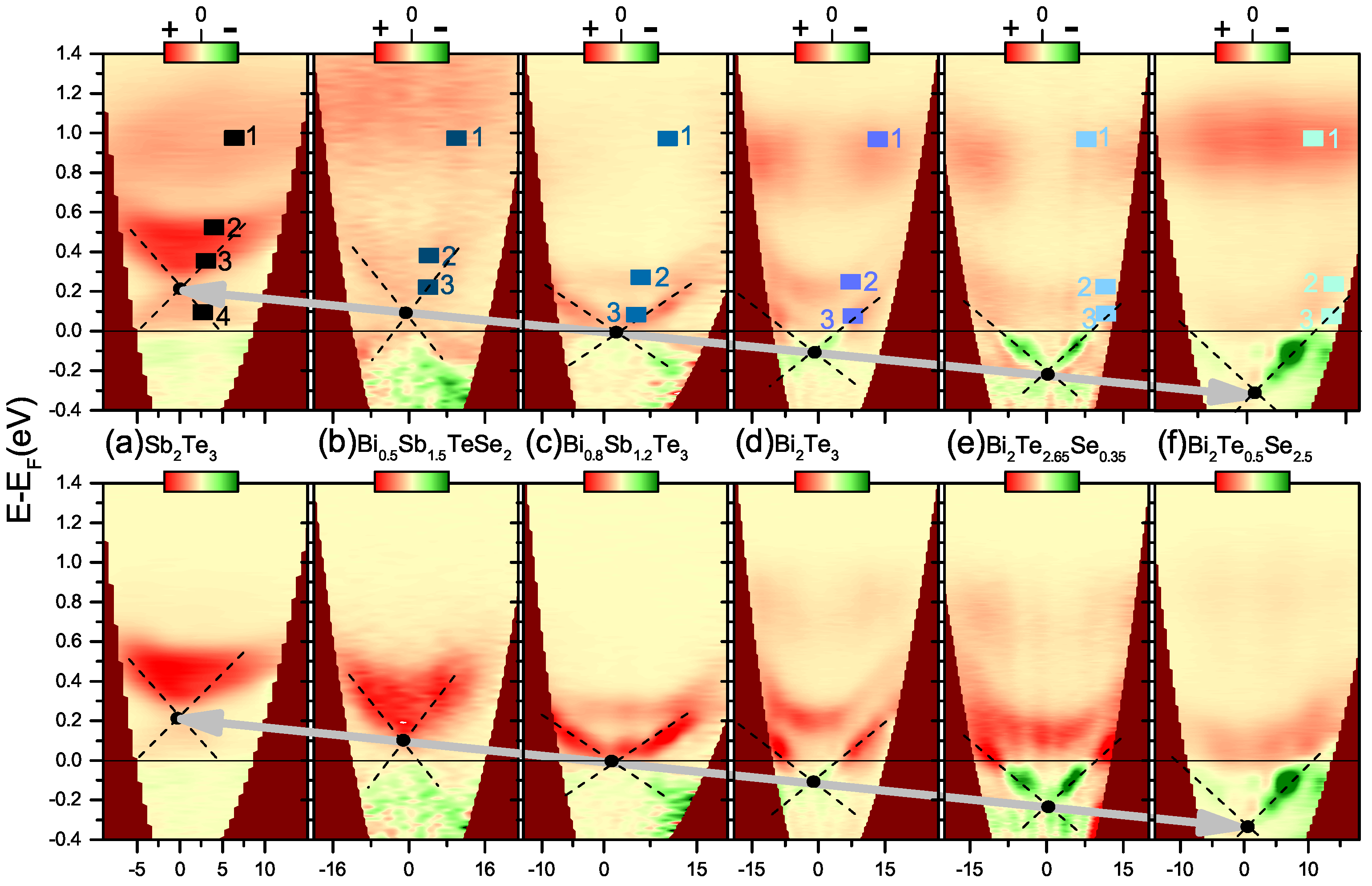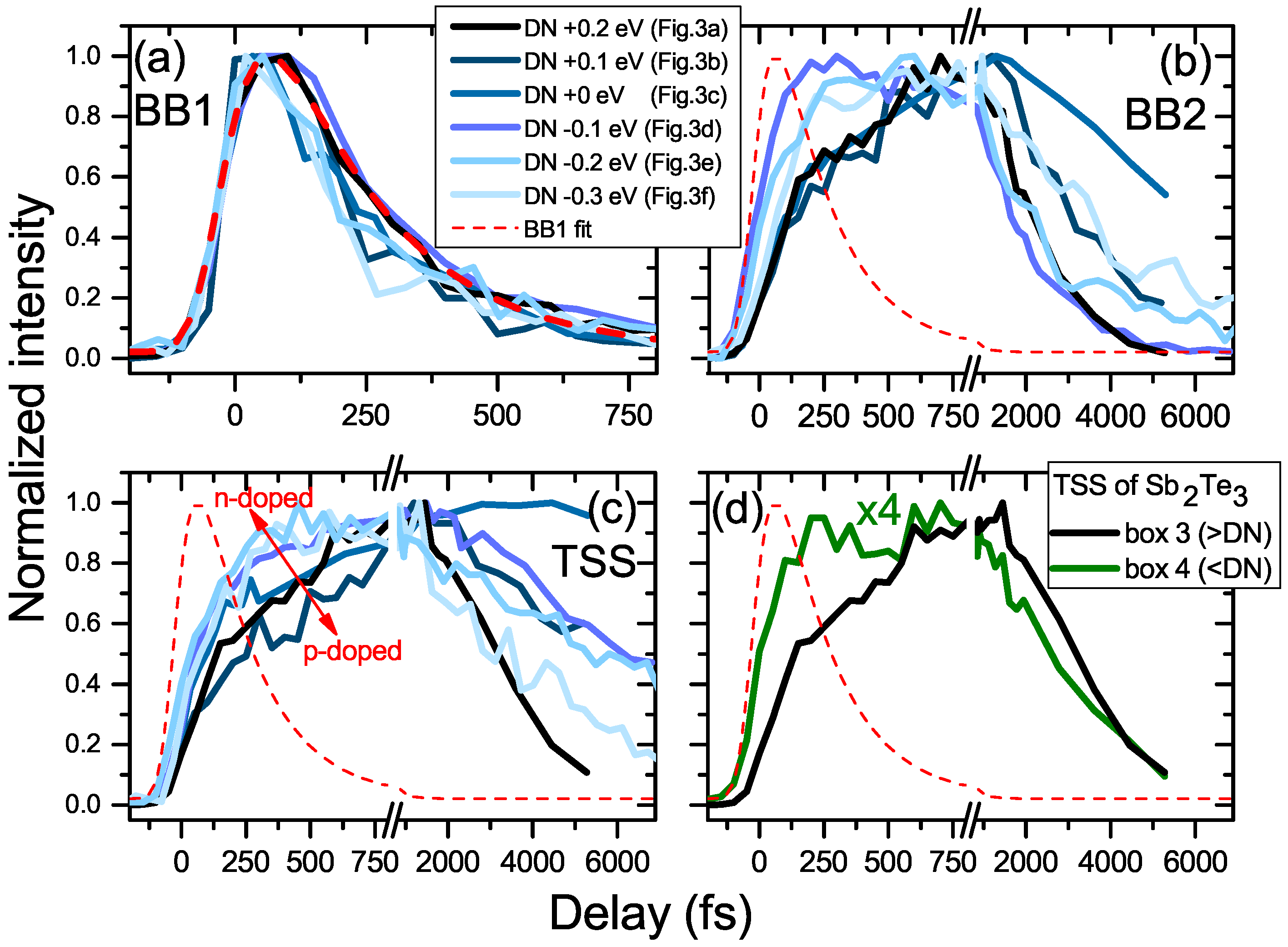Surface State Dynamics of Topological Insulators Investigated by Femtosecond Time- and Angle-Resolved Photoemission Spectroscopy
Abstract
1. Introduction
2. Materials and Methods
3. Results and Discussion
4. Conclusions
Author Contributions
Acknowledgments
Conflicts of Interest
References
- Moore, J.E. The birth of topological insulators. Nature 2010, 464, 194–198. [Google Scholar] [CrossRef] [PubMed]
- Hsieh, D.; Qian, D.; Wray, L.; Xia, Y.; Hor, Y.S.; Cava, R.J.; Hasan, M.Z. A topological Dirac insulator in a quantum spin Hall phase. Nature 2008, 452, 970–974. [Google Scholar] [CrossRef] [PubMed]
- Hsieh, D.; Xia, Y.; Wray, L.; Qian, D.; Pal, A.; Dil, J.; Osterwalder, J.; Meier, F.; Bihlmayer, G.; Kane, C.; et al. Observation of unconventional quantum spin textures in topological insulators. Science 2009, 323, 919–922. [Google Scholar] [CrossRef] [PubMed]
- Qi, X.L.; Hughes, T.L.; Zhang, S.C. Fractional charge and quantized current in the quantum spin Hall state. Nat. Phys. 2008, 4, 273–276. [Google Scholar] [CrossRef]
- Fu, L.; Kane, C.L. Superconducting proximity effect and Majorana fermions at the surface of a topological insulator. Phys. Rev. Lett. 2008, 100, 096407. [Google Scholar] [CrossRef] [PubMed]
- Essin, A.M.; Moore, J.E.; Vanderbilt, D. Magnetoelectric polarizability and axion electrodynamics in crystalline insulators. Phys. Rev. Lett. 2009, 102, 146805. [Google Scholar] [CrossRef] [PubMed]
- Qi, X.L.; Li, R.; Zang, J.; Zhang, S.C. Inducing a magnetic monopole with topological surface states. Science 2009, 323, 1184–1187. [Google Scholar] [CrossRef] [PubMed]
- Li, R.; Wang, J.; Qi, X.L.; Zhang, S.C. Dynamical axion field in topological magnetic insulators. Nat. Phys. 2010, 6, 284–288. [Google Scholar] [CrossRef]
- Yu, R.; Zhang, W.; Zhang, H.J.; Zhang, S.C.; Dai, X.; Fang, Z. Quantized anomalous Hall effect in magnetic topological insulators. Science 2010, 329, 61–64. [Google Scholar] [CrossRef] [PubMed]
- Butch, N.P.; Kirshenbaum, K.; Syers, P.; Sushkov, A.B.; Jenkins, G.S.; Drew, H.D.; Paglione, J. Strong surface scattering in ultrahigh-mobility Bi2Se3 topological insulator crystals. Phys. Rev. B 2010, 81, 241301. [Google Scholar] [CrossRef]
- Ren, Z.; Taskin, A.; Sasaki, S.; Segawa, K.; Ando, Y. Large bulk resistivity and surface quantum oscillations in the topological insulator Bi2Te2Se. Phys. Rev. B 2010, 82, 241306. [Google Scholar] [CrossRef]
- Yoshimi, R.; Tsukazaki, A.; Kozuka, Y.; Falson, J.; Takahashi, K.; Checkelsky, J.; Nagaosa, N.; Kawasaki, M.; Tokura, Y. Quantum Hall effect on top and bottom surface states of topological insulator (Bi1-xSbx)2Te3 films. arXiv, 2014; arXiv:1409.3326. [Google Scholar]
- Xia, B.; Ren, P.; Sulaev, A.; Liu, P.; Shen, S.Q.; Wang, L. Indications of surface-dominated transport in single crystalline nanoflake devices of topological insulator Bi1.5Sb0.5Te1.8Se1.2. Phys. Rev. B 2013, 87, 085442. [Google Scholar] [CrossRef]
- Xu, Y.; Miotkowski, I.; Liu, C.; Tian, J.; Nam, H.; Alidoust, N.; Hu, J.; Shih, C.K.; Hasan, M.Z.; Chen, Y.P. Observation of topological surface state quantum Hall effect in an intrinsic three-dimensional topological insulator. Nat. Phys. 2014, 10, 956–963. [Google Scholar] [CrossRef]
- Neupane, M.; Xu, S.Y.; Wray, L.A.; Petersen, A.; Shankar, R.; Alidoust, N.; Liu, C.; Fedorov, A.; Ji, H.; Allred, J.M.; et al. Topological surface states and Dirac point tuning in ternary topological insulators. Phys. Rev. B 2012, 85, 235406. [Google Scholar] [CrossRef]
- Arakane, T.; Sato, T.; Souma, S.; Kosaka, K.; Nakayama, K.; Komatsu, M.; Takahashi, T.; Ren, Z.; Segawa, K.; Ando, Y. Tunable Dirac cone in the topological insulator Bi2-xSbxTe3-ySey. Nat. Commun. 2012, 3, 636. [Google Scholar] [CrossRef] [PubMed]
- Chen, C.; Xie, Z.; Feng, Y.; Yi, H.; Liang, A.; He, S.; Mou, D.; He, J.; Peng, Y.; Liu, X.; et al. Tunable Dirac fermion dynamics in topological insulators. Sci. Rep. 2013, 3. [Google Scholar] [CrossRef] [PubMed]
- Sterzi, A.; Manzoni, G.; Sbuelz, L.; Cilento, F.; Zacchigna, M.; Bugnon, P.; Magrez, A.; Berger, H.; Crepaldi, A.; Parmigiani, F. Bulk diffusive relaxation mechanisms in optically excited topological insulators. Phys. Rev. B 2017, 95, 115431. [Google Scholar] [CrossRef]
- Pan, Z.H.; Fedorov, A.; Gardner, D.; Lee, Y.; Chu, S.; Valla, T. Measurement of an exceptionally weak electron-phonon coupling on the surface of the topological insulator Bi2Se3 using angle-resolved photoemission spectroscopy. Phys. Rev. Lett. 2012, 108, 187001. [Google Scholar] [CrossRef] [PubMed]
- Damascelli, A.; Hussain, Z.; Shen, Z.X. Angle-resolved photoemission studies of the cuprate superconductors. Rev. Mod. Phys. 2003, 75, 473. [Google Scholar] [CrossRef]
- Chen, Y.; Analytis, J.G.; Chu, J.H.; Liu, Z.; Mo, S.K.; Qi, X.L.; Zhang, H.; Lu, D.; Dai, X.; Fang, Z.; et al. Experimental realization of a three-dimensional topological insulator, Bi2Te3. Science 2009, 325, 178–181. [Google Scholar] [CrossRef] [PubMed]
- Sobota, J.A.; Yang, S.; Analytis, J.G.; Chen, Y.; Fisher, I.R.; Kirchmann, P.S.; Shen, Z.X. Ultrafast optical excitation of a persistent surface-state population in the topological insulator Bi2Se3. Phys. Rev. Lett. 2012, 108, 117403. [Google Scholar] [CrossRef] [PubMed]
- Hajlaoui, M.; Papalazarou, E.; Mauchain, J.; Perfetti, L.; Taleb-Ibrahimi, A.; Navarin, F.; Monteverde, M.; Auban-Senzier, P.; Pasquier, C.; Moisan, N.; et al. Tuning a Schottky barrier in a photoexcited topological insulator with transient Dirac cone electron-hole asymmetry. Nat. Commun. 2014, 5, 3003. [Google Scholar] [CrossRef] [PubMed]
- Crepaldi, A.; Ressel, B.; Cilento, F.; Zacchigna, M.; Grazioli, C.; Berger, H.; Bugnon, P.; Kern, K.; Grioni, M.; Parmigiani, F. Ultrafast photodoping and effective Fermi-Dirac distribution of the Dirac particles in Bi2Se3. Phys. Rev. B 2012, 86, 205133. [Google Scholar] [CrossRef]
- Bugini, D.; Boschini, F.; Hedayat, H.; Yi, H.; Chen, C.; Zhou, X.; Manzoni, C.; Dallera, C.; Cerullo, G.; Carpene, E. Ultrafast spin-polarized electron dynamics in the unoccupied topological surface state of Bi2Se3. J. Phys. Condens. Matter 2017, 29, 30LT01. [Google Scholar] [CrossRef] [PubMed]
- Hedayat, H.; Bugini, D.; Yi, H.; Chen, C.; Zhou, X.; Cerullo, G.; Dallera, C.; Carpene, E. Femtosecond dynamics of spin-polarized electrons in topological insulators. IEEE Magn. Lett. 2017. [Google Scholar] [CrossRef]
- Zhu, S.; Ishida, Y.; Kuroda, K.; Sumida, K.; Ye, M.; Wang, J.; Pan, H.; Taniguchi, M.; Qiao, S.; Shin, S.; et al. Ultrafast electron dynamics at the Dirac node of the topological insulator Sb2Te3. Sci. Rep. 2015, 5, 13213. [Google Scholar] [CrossRef] [PubMed]
- Chen, C.; He, S.; Weng, H.; Zhang, W.; Zhao, L.; Liu, H.; Jia, X.; Mou, D.; Liu, S.; He, J.; et al. Robustness of topological order and formation of quantum well states in topological insulators exposed to ambient environment. Proc. Natl. Acad. Sci. USA 2012, 109, 3694. [Google Scholar] [CrossRef] [PubMed]
- Boschini, F.; Hedayat, H.; Dallera, C.; Farinello, P.; Manzoni, C.; Magrez, A.; Berger, H.; Cerullo, G.; Carpene, E. An innovative Yb-based ultrafast deep ultraviolet source for time-resolved photoemission experiments. Rev. Sci. Instr. 2014, 85, 123903. [Google Scholar] [CrossRef] [PubMed]
- Carpene, E.; Mancini, E.; Dallera, C.; Ghiringhelli, G.; Manzoni, C.; Cerullo, G.; De Silvestri, S. A versatile apparatus for time-resolved photoemission spectroscopy via femtosecond pump-probe experiments. Rev. Sci. Instr. 2009, 80, 055101. [Google Scholar] [CrossRef] [PubMed]
- Hajlaoui, M.; Papalazarou, E.; Mauchain, J.; Lantz, G.; Moisan, N.; Boschetto, D.; Jiang, Z.; Miotkowski, I.; Chen, Y.; Taleb-Ibrahimi, A.; et al. Ultrafast surface carrier dynamics in the topological insulator Bi2Te3. Nano Lett. 2012, 12, 3532–3536. [Google Scholar] [CrossRef] [PubMed]
- Sánchez-Barriga, J.; Battiato, M.; Krivenkov, M.; Golias, E.; Varykhalov, A.; Romualdi, A.; Yashina, L.; Minár, J.; Kornilov, O.; Ebert, H.; et al. Subpicosecond spin dynamics of excited states in the topological insulator Bi2Te3. Phys. Rev. B 2017, 95, 125405. [Google Scholar] [CrossRef]
- Neupane, M.; Xu, S.Y.; Ishida, Y.; Jia, S.; Fregoso, B.M.; Liu, C.; Belopolski, I.; Bian, G.; Alidoust, N.; Durakiewicz, T.; et al. Gigantic surface lifetime of an intrinsic topological insulator. Phys. Rev. Lett. 2015, 115, 116801. [Google Scholar] [CrossRef] [PubMed]
- Cacho, C.; Crepaldi, A.; Battiato, M.; Braun, J.; Cilento, F.; Zacchigna, M.; Richter, M.; Heckmann, O.; Springate, E.; Liu, Y.; et al. Momentum-resolved spin dynamics of bulk and surface excited states in the topological insulator Bi2Se3. Phys. Rev. Lett. 2015, 114, 097401. [Google Scholar] [CrossRef] [PubMed]
- Jozwiak, C.; Sobota, J.A.; Gotlieb, K.; Kemper, A.F.; Rotundu, C.R.; Birgeneau, R.J.; Hussain, Z.; Lee, D.H.; Shen, Z.X.; Lanzara, A. Spin-polarized surface resonances accompanying topological surface state formation. Nat. Commun. 2016, 7, 13143. [Google Scholar] [CrossRef] [PubMed]
- Sumida, K.; Ishida, I.; Zhu, S.; Ye, M.; Pertsova, A.; Triola, C.; Kokh, K.A.; Tereshchenko, O.E.; Balatsky, A.V.; Shin, S.; Kimura, A. Prolonged duration of nonequilibrated Dirac fermion in neutral topological insulators. Sci. Rep. 2017, 7, 14080. [Google Scholar] [CrossRef] [PubMed]





© 2018 by the authors. Licensee MDPI, Basel, Switzerland. This article is an open access article distributed under the terms and conditions of the Creative Commons Attribution (CC BY) license (http://creativecommons.org/licenses/by/4.0/).
Share and Cite
Hedayat, H.; Bugini, D.; Yi, H.; Chen, C.; Zhou, X.; Cerullo, G.; Dallera, C.; Carpene, E. Surface State Dynamics of Topological Insulators Investigated by Femtosecond Time- and Angle-Resolved Photoemission Spectroscopy. Appl. Sci. 2018, 8, 694. https://doi.org/10.3390/app8050694
Hedayat H, Bugini D, Yi H, Chen C, Zhou X, Cerullo G, Dallera C, Carpene E. Surface State Dynamics of Topological Insulators Investigated by Femtosecond Time- and Angle-Resolved Photoemission Spectroscopy. Applied Sciences. 2018; 8(5):694. https://doi.org/10.3390/app8050694
Chicago/Turabian StyleHedayat, Hamoon, Davide Bugini, Hemian Yi, Chaoyu Chen, Xingjiang Zhou, Giulio Cerullo, Claudia Dallera, and Ettore Carpene. 2018. "Surface State Dynamics of Topological Insulators Investigated by Femtosecond Time- and Angle-Resolved Photoemission Spectroscopy" Applied Sciences 8, no. 5: 694. https://doi.org/10.3390/app8050694
APA StyleHedayat, H., Bugini, D., Yi, H., Chen, C., Zhou, X., Cerullo, G., Dallera, C., & Carpene, E. (2018). Surface State Dynamics of Topological Insulators Investigated by Femtosecond Time- and Angle-Resolved Photoemission Spectroscopy. Applied Sciences, 8(5), 694. https://doi.org/10.3390/app8050694






